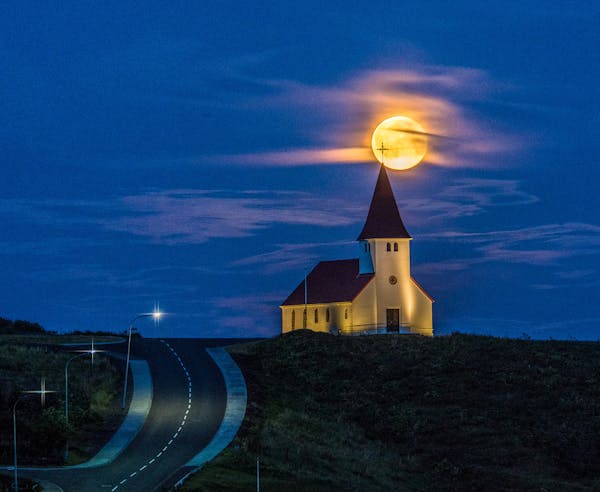Findlater Castle came into view like a mirage — an abandoned fortress camouflaged against Scotland's lonely northern coast.
I had seen crumbled British coastal ruins before, but here I could make out actual windows, stone arches and columns. My companion Sabrina and I hiked down to the castle rock on a slippery path lacking signage. The entrance to a former stairwell, hidden on top of the grassy mound, led us into an underground suite. Perhaps this was the basement quarters of a once-fearsome citadel on the top of the known world.
We took cover below from a passing August shower. One vertigo-inspiring chamber sloped downward to a wide archlike opening, with nothing to protect us from falling 90 feet into the crashing waves. Save for two hulking oil tankers sitting stationary out in the North Sea, we might have stepped into the 16th century. Back outside, with her ginger hair blowing in the offshore wind, Sabrina looked like a Celtic fairy hiding in the long grass.
Findlater (locally pronounced "fin-li-uh") was an unexpected highlight of our 11-day Scotland trip, but it wasn't on any tourist maps I had seen. We had only learned about it through word of mouth.
We were touring Scotland, from Glasgow to Orkney, because Sabrina's co-worker in St. Paul had hooked her up with an invitation to stay in a classic Scottish country house — a prospect that we had required 10 seconds to think about. One day Sabrina booked a pony-riding lesson at the remote Wardhaugh Farm riding school. She spent the morning seeing the "patchwork" Aberdeenshire countryside on a small horse, while I drove to the Shakespearean-sounding town of Macduff and took pictures of a cemetery perched high above the sea. It was Sabrina's friendly, self-described "horsey" guide, Amanda, who instructed us to look down the Banffshire coast for Findlater.
This almost-forgotten castle was fortified around 1455 under the auspices of King James II, of the legendary House of Stuart. But by 1562, as if the Scots were bingeing on a particularly contentious season of "Game of Thrones," Findlater fell into the hands of the Gordon family, who decided to rebel against Mary, Queen of Scots, after their son was denied her hand in marriage. Although Findlater is described on a modest plaque as "a castle so fortified by the nature of its situation as to seem impregnable," the Stuart forces quickly crushed the Gordons.
Findlater would fall into decay, but endure as a reminder of the Scottish rebel spirit. Throughout our time in the country, I repeatedly came back to themes of Scottish independence and rebellion, past and present.
At the Fringe
Three days earlier we had arrived by train in the capital of Edinburgh. After climbing the stairs up a steep and narrow close (alleyway) in the city's Old Town, we emerged into a motley sea of humanity on the Royal Mile — dancers, acrobats and burlesque performers on makeshift stages, handing out fliers for their shows in the sprawling Fringe Festival. One flier promised something more historical: a special exhibition at the Scottish National Museum on "Bonnie Prince Charlie and the Jacobites."
Judging from the crowd at the well-curated exhibit, the 18th-century Jacobite movement is a romantic source of nostalgia and national identity for many Scots — owing partly to the gauzy "Outlander" novels and TV drama, about a headstrong Englishwoman traveler who steps into a stone circle and is zapped back in time. In a tragicomic series of campaigns, the Jacobites tried to restore the Catholic House of Stuart to the British throne. The most famous was Charles Edward Stuart, aka Bonnie Prince Charlie or "The Young Pretender," who sailed from his exile in France to lead the uprising of 1745.
After the exhibit, we had seen enough of museums for now. We had come to Edinburgh at the wildest time of year, with nightly fireworks and the 250 bagpipers of the Massed Pipes and Drums performing outside the 11th-century Edinburgh Castle. The morning after a full night of Fringe-ing, I headed solo to the top of the Royal Mile for a self-guided tour of the castle, Scotland's most visited attraction.
At the top of the medieval complex lay the relatively modest Royal Palace, where lines formed out the doors to view a small room of almost holy significance. Here, in 1566, Mary, Queen of Scots gave birth to James VI, the Stuart king who would assume the crowns of both Scotland and England, commencing a 111-year glory age for Stuart monarchs.
From the castle, I walked downhill to the opposite end of the Royal Mile and gazed at the more stately Holyrood Palace, where Queen Elizabeth lives for a week a year. When Bonnie Prince Charlie, the Jacobite pretender, marched on Edinburgh in 1745, he failed to capture the castle where great-great-grandfather James VI was born, but he did hold court at Holyrood for five weeks in September and October.
Mirroring that ancient history, Holyrood sits across a narrow lane from the shockingly postmodern facade of the 2004 Scottish Parliament Building, where the pro-independence Scottish National Party today holds a governing plurality. Voters narrowly overturned a 2014 independence referendum, but in light of Brexit — which was quite unpopular here — interesting political times may yet lie ahead.
Into the Highlands
After two days and nights in Edinburgh, we took the train north. I caught glimpses of white wind turbines on the east coast, standing side by side with black North Sea oil rigs — old energy and new energy working together. We disembarked in Aberdeen, best known in the U.S. for its controversial golf course owned by Donald Trump. After stopping at the waterfront to buy smoked haddock for our hosts, we rented a car at the small airport to drive to our Scottish country house.
I knew just a little about where we were going. I must confess that my interest in the Jacobites had an even nerdier source than "Outlander": an epic 1976 song by the English band Genesis called "Eleventh Earl of Mar," in which Phil Collins sings of a hubristic traitor. So it wasn't lost on me that our country lodging was quite close to the historic province of Mar — now a modern unit of Aberdeenshire called Marr.
When I mentioned Bonnie Prince Charlie to the hospitable, English-born laird of our manor, he poured me a dram of fine whisky and quipped, "I hope you've gleaned that Charles' real intention was to install himself on the English throne as well. The Jacobites would have set Scotland back 100 years — and England 200 years." Indeed, Charlie's downfall was refusing to stop with Scotland, marching southward on an ill-fated power grab. Sang Phil Collins, "They're headed for London/ And that would be their grave."
But Jacobite mania is alive and well in the north: An official "Jacobite Trail" features 26 historic sites all over the country, including castles in Marr. The day after our Findlater adventure, we finally took the narrow, winding roads into the Highlands, which appeared as massive round hills crowned in thick, beautiful purple heather.
The very first stop was Kildrummy, "the noblest of northern castles." The 13th-century structure was older than Findlater, but its grand floor plan was discernible. The well-groomed ruins looked like a TV-show set, where lovebirds on "The Bachelor" might have a romantic dinner date. But imagine my excitement to discover that Kildrummy was home base for the Earls of Mar! In 1715, a generation before Charlie, the double-dealing 11th earl John Erskine, aka "Bobbing John," plotted a Jacobite uprising here. After his defeat, the earl fled to France and Kildrummy's days as a noble residence ended.
Much more of the Jacobite Trail remained, but Sabrina and I were beginning to feel something that's inevitable in a U.K. trip: the onset of "castle fatigue." So we rounded out the day with a swing by two famous distilleries, Glenlivet and Glenfiddich. We didn't spring for an extremely expensive bottle of Scotch, but we learned more about what to order at home.
The irony of the Jacobites is that Charlie seemed a fool — a foppish, French-styled rock star; "dressed too fine, and smelling of wine," as the song goes. Outside Inverness, you can visit Culloden, the site of the 1745 final stand. Any Scot can tell you that Charlie's tactical error was meeting the Redcoats in an open field, not suited to the Highlanders' guerrilla tactics. The rebels were decimated, Charlie disgraced, and as punishment the people were stripped of their traditional dress. Scotland was down — but never, ever out.
Simon Peter Groebner • Instagram: @simonpeter6
Dr. Martens shares plunge to record low after weak US revenue outlook
Visa fees for international artists to tour in the US shot up 250% in April. It could be devastating

Executor of O.J. Simpson's estate plans to fight payout to the families of Brown and Goldman

